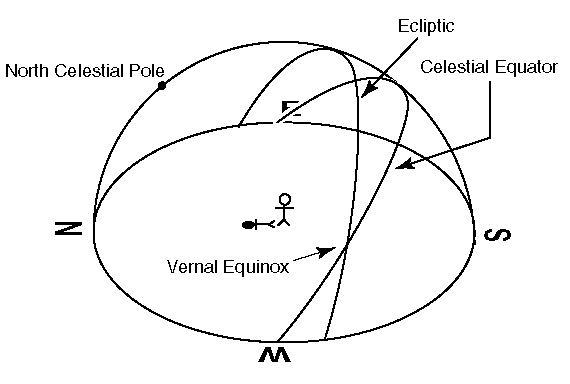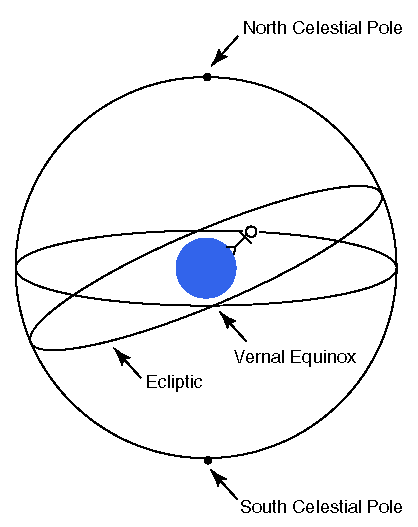Term: ecliptic, equinox
The stars on the celestial sphere don't move relative to each other.
The apparent motion of the stars in the sky during a night is due to the rotation
of the whole celestial sphere. There are a handful of objects,
called by the Greeks "wanderers" or planets, that do move relative to
the stars on the celestial sphere. The most obvious of these wanderers
is the Sun. The Sun moves only about 1° per day, but over a year
it completes a great circle on the celestial sphere. The path of the
Sun on the celestial sphere is called the ecliptic. The ecliptic
is inclined about 23.5° compared to the celestial equator.
Thus during half the year the Sun is north of the celestial equator,
and the Sun follows a path in the sky like the red star on the previous
page. It rises north of east, culminates high in the sky, and sets north
of west. During the other half of the year the Sun follows a path
like the green star on the previous page. It rises south of east,
culminates below the celestial equator, and sets south of west.
The moments, two each year, when the Sun moves between hemispheres
are called equinoxes; one happens around March 21, the other
around September 21. The spring equinox (when the Sun moves from the
southern hemisphere to the northern hemisphere) is called the vernal
equinox


This is what the ecliptic looks like on the
full celestial sphere. Note that the Sun slowly moves on the
celestial sphere in the opposite direction that the celestial sphere
rotates. Thus in this picture, if we stopped the sphere's rotation
while the Sun was on the surface facing you, the Sun would be
slowly creeping to your right. In the first picture, the Sun would
be creeping to the east if the celestial sphere stopped rotating.
But since the creep of the Sun along the ecliptic (one rotation per
year) is so much slower than the daily rotation of the whole celestial sphere
(one rotation per day), the Sun is seen to move from east to west in our
sky.
NEXT


